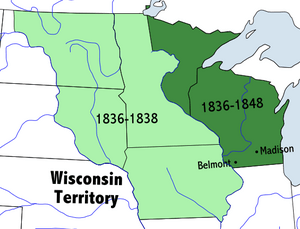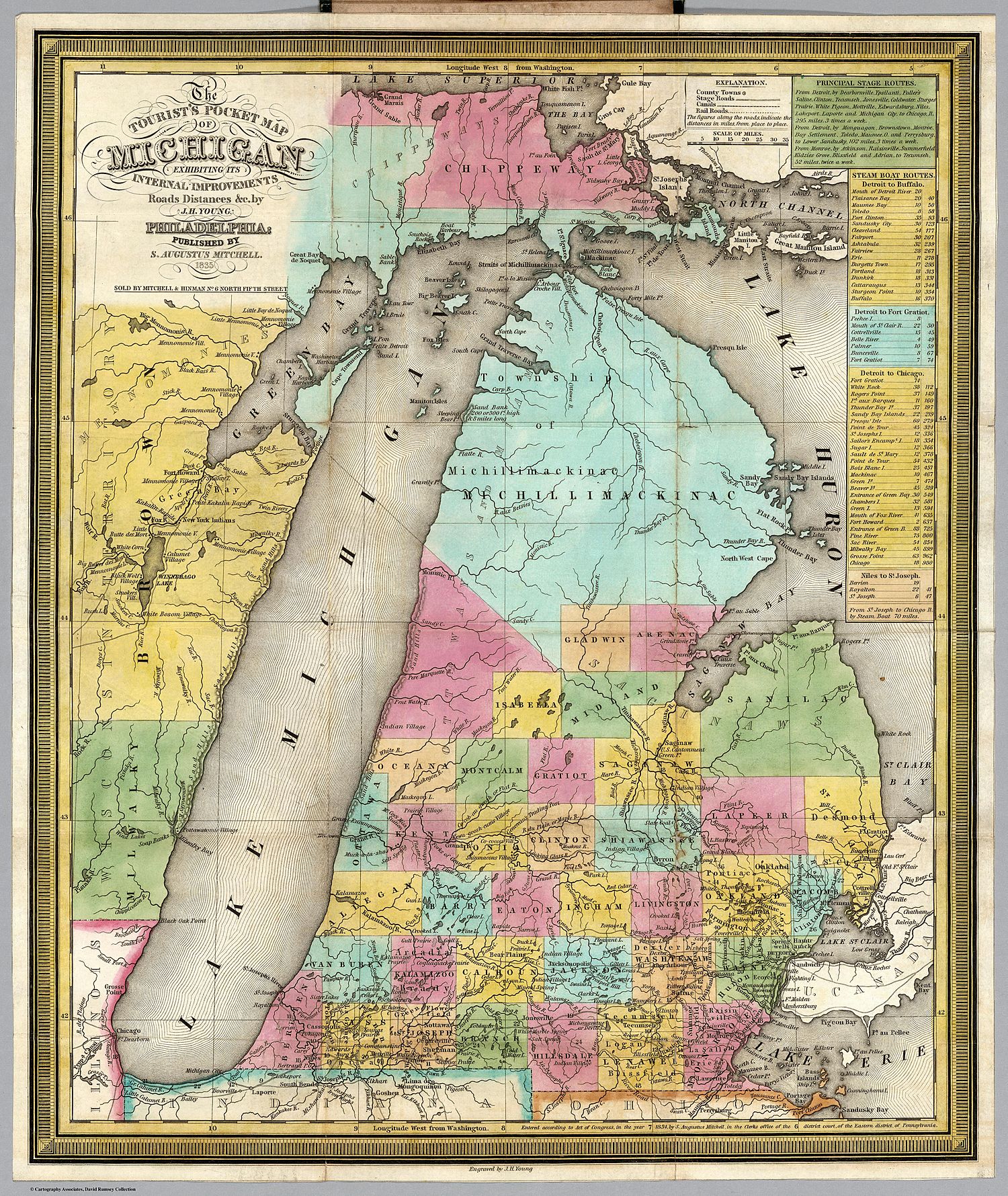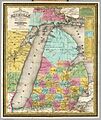Wisconsin Territory facts for kids
Quick facts for kids Territory of Wisconsin |
|||||||||||||
|---|---|---|---|---|---|---|---|---|---|---|---|---|---|
| Organized incorporated territory of the United States | |||||||||||||
| 1836–1848 | |||||||||||||
 Map of the Wisconsin Territory, 1836–1848 |
|||||||||||||
| Capital | Madison (1838–1848) Burlington (1837) Belmont (July–December 1836) |
||||||||||||
| Government | |||||||||||||
| • Type | Organized incorporated territory | ||||||||||||
| Governor | |||||||||||||
|
• 1836–1841
|
Henry Dodge | ||||||||||||
|
• 1841–1844
|
James Duane Doty | ||||||||||||
|
• 1844–1845
|
Nathaniel P. Tallmadge | ||||||||||||
|
• 1845–1848
|
Henry Dodge | ||||||||||||
|
• 1848
|
John Catlin (acting) | ||||||||||||
| Legislature | Legislative Assembly of the Territory of Wisconsin | ||||||||||||
| History | |||||||||||||
|
• Organic Act effective
|
3 July 1836 | ||||||||||||
|
• Iowa Territory split off
|
July 4, 1838 | ||||||||||||
| 29 May 1848 | |||||||||||||
|
|||||||||||||
The Territory of Wisconsin was a part of the United States that was set up to be governed before it could become a state. It existed from July 3, 1836, until May 29, 1848. On that date, the eastern part of the territory became the State of Wisconsin.
At first, Belmont was chosen as the capital city. In 1837, the government met in Burlington. This city later became part of the Iowa Territory in 1838. In that same year, 1838, the capital of the Wisconsin Territory moved to Madison.
Contents
Where Was the Wisconsin Territory?
The Wisconsin Territory was very large when it first started. It included all of what are now the states of Wisconsin, Minnesota, and Iowa. It also included parts of North Dakota and South Dakota that are east of the Missouri River.
Much of this land was once part of the Northwest Territory. This area was given to the United States by Great Britain in 1783. The land that is now Iowa and the Dakotas was bought by the U.S. in the Louisiana Purchase. This part was later added to the Michigan Territory in 1834.
The area that became Wisconsin was part of the Indiana Territory in 1800. Later, it joined the Illinois Territory in 1809. When Illinois was about to become a state in 1818, this land was moved to the Michigan Territory. Finally, the Wisconsin Territory was created from the Michigan Territory in 1836. This happened as Michigan was getting ready to become a state.
In 1838, the land west of the Mississippi River became the Iowa Territory. This made the Wisconsin Territory much smaller. It stayed this size for ten years. When Wisconsin became a state, its borders were set to what they are today.
Early History of the Territory
There were some confusing times when the Wisconsin Territory was first being set up. Michigan wanted to become a state. Even though Congress said no at first, Michigan started governing itself in October 1835. Michigan officially became a state in January 1837. However, Congress didn't create the Wisconsin Territory until July 3, 1836.
To keep things running, the acting Governor of the Michigan Territory, Stevens T. Mason, called for an election. He wanted a special group of lawmakers to meet in Green Bay on January 1, 1836. But then, President Andrew Jackson replaced Mason with John S. Horner. Horner changed the meeting date to December 1, 1835. This gave the elected people very little time to get ready. Many of them were annoyed and didn't show up. Even Horner didn't attend. The meeting happened on January 1 as planned, but without the Governor, they couldn't do much.
President Jackson chose Henry Dodge to be the first Governor of the Wisconsin Territory. He also appointed John S. Horner as the Secretary. The first group of lawmakers met in Belmont on October 25, 1836. In 1837, Burlington became the second capital. The next year, the Iowa Territory was created, and the capital moved to Madison.
How Wisconsin Became a State
In 1846, the U.S. Congress passed the Wisconsin Enabling Act. This was an important step for Wisconsin to become a state. Wisconsin was going to be the fifth state created from the old Northwest Territory.
Morgan Lewis Martin, who represented Wisconsin in Congress, wanted the new state to include all the remaining land from the original Northwest Territory. But most members of Congress thought this would make the state too big. They decided that Congress didn't have to follow the old rules exactly. They passed a law that allowed a sixth state to be formed from the rest of the Northwest Territory.
Later, in 1847 and 1848, there were ideas to create a new "Territory of Minasota." But these ideas were rejected. This was because "Minasota" didn't have enough free adult males to become a legal territory.
Wisconsin Territory After Statehood
When Wisconsin became a state on May 29, 1848, some land was left over. This land was between the St. Croix River and the Mississippi River. It had been part of the Wisconsin Territory, but no plans were made for it. Also, when Iowa became a state in 1846, the rest of the Iowa Territory was not officially organized.
In the summer of 1848, people in this leftover area started holding meetings. The person who represented the territory in Congress, John Hubbard Tweedy, resigned. So, John Catlin, who was the acting governor, went to Stillwater, Minnesota. He called for a special election to fill the empty seat. Henry Hastings Sibley won this election on October 30.
When Sibley went to Washington, D.C., Congress didn't immediately accept him. After a long discussion, he was allowed to take his seat on January 15, 1849. For a short time, there were representatives in Congress from both the State of Wisconsin and the Territory of Wisconsin. This had never happened before! Sibley's main goal was to create the Territory of Minnesota. This finally happened on March 3, 1849.
Leaders of the Wisconsin Territory
Secretaries of the Territory
- John S. Horner (1836–1837)
- William B. Slaughter (1837–1841)
- Francis J. Dunn (1841)
- Alexander P. Field (1841–1843)
- George Rogers Clark Floyd (1843–1846)
- John Catlin (1846–1848)
Territorial Legislature
The government of the Wisconsin Territory had two parts: a council (like a senate) and a group of representatives. The first meeting was in Belmont on October 25, 1836. It ended on December 9, 1836. The council had 14 members, led by Henry S. Baird. There were 26 representatives. The Speaker of the House was Peter H. Engle.
The last meeting of the legislature was from February 7 to March 13, 1848. The council had 13 members, led by Horatio N. Wells. The House of Representatives had 26 members, and its speaker was Timothy Burns.
Attorneys General of the Territory
- Henry S. Baird (1836–1839)
- Horatio N. Wells (1839–1841)
- Mortimer M. Jackson (1841–1845)
- William Pitt Lynde (1845)
- A. Hyatt Smith (1845–1848)
Representatives in Congress
These people represented the Wisconsin Territory in the U.S. Congress:
- George Wallace Jones (1836–1838)
- James Duane Doty (1839–1841)
- Henry Dodge (1841–1845)
- Morgan Lewis Martin (1845–1847)
- John Hubbard Tweedy (1847–1848)
- Henry Hastings Sibley (1848–1849)
Images for kids
-
The Wisconsin Territory as depicted on this 1835 Tourist's Pocket Map of Michigan, showing a Menominee-filled Brown County, Wisconsin that spans the northern half of the territory
See also
 In Spanish: Territorio de Wisconsin para niños
In Spanish: Territorio de Wisconsin para niños




